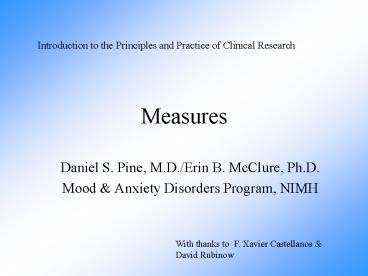Measures - PowerPoint PPT Presentation
1 / 25
Title: Measures
1
Measures
Introduction to the Principles and Practice of
Clinical Research
- Daniel S. Pine, M.D./Erin B. McClure, Ph.D.
- Mood Anxiety Disorders Program, NIMH
With thanks to F. Xavier Castellanos David
Rubinow
2
The Uncertainty Principle
- The more precisely the POSITION is determined,
the less precisely the MOMENTUM is known. -
Werner Heisenberg
3
Introduction
- Measure selection must be informed by
well-defined, answerable questions - Results are only as good as the worst measure and
are never perfect Types of measures - Types of error (random non-random)
- Non-random error (bias) ? Type I error (false
positives) - Would you vote for this moderately intelligent
candidate? - Random error ? Type II error (low power)
- What will you do on November 2nd?
- Reliability limits statements on validity
- XXXX is more likely to win on November 2nd.
4
Outline Operational Questions
- 1. What is a measure/variable?
- 2. How do you measure?
- 3. How do you test measures (Reliability/Validity)
? - 4. How do you select measures?
- 5. What factors influence the measures?
- 6. When is the measure obtained and how often?
5
What is a measure?
- Something that varies in an observable,
quantifiable fashion - Measure true value error
- Error random error biased error
- Central limit theorem eliminates effects of
random error - http//www.stat.sc.edu/west/javahtml/CLT.html
- http//www.math.uah.edu/stat/sample/sample5.html
6
Central Limit Theorem in ActionSum of All Rolled
Dice
Two Dice
One Die
Three Dice
Four Dice
7
Outline Types of Scales(What You Measure With)
- Nominal or Categorical
- Classification or set of categories mutually
exclusive and collectively exhaustive e.g.,
gender sick vs. healthy - Ordinal
- Mutually exclusive classes that form an ordered
series rank order e.g., grades on a statistics
test seriousness of a tumor - Interval
- Ordered series of ranks with equal intervals
between any two pairs of adjacent classes e.g.,
temperature - Ratio
- An interval scale with a true zero point origin
e.g., weight
8
Categorical/Nominal Measures
- hanging chad only one corner of the almost
completely punched-out piece of paper is still
connected to the ballot - swinging chad 2 corners remain attached,
resembling a door - tri-chad 3 corners remain attached and only one
corner is flapping outward, but some pushed-away
space is evident - pregnant chad the rectangle has a bulge and
seems to have been lightly punched, but all four
corners are still attached - dimpled chad the space has a slight
indentation, but the corners remain connected
Gannett News Service
9
Categorical/Nominal Measures
- Classification or set of categories mutually
exclusive and collectively exhaustive - Statistical operation Counting
- Caseness
- Criteria lifetime vs. current symptoms
- Comorbid conditions
- Subthreshold non-cases
- Fundamental process in epidemiology
10
Ordinal Scales
- e.g., Rating Scales, IQ
- Subjectivity
- Floor/Ceiling effects common
11
Implications of Scale Type
- Determine which statistical operations are
permissible - Parametric
- Non-parametric
- Within subject comparisons
- Between subject comparisons
12
How Do You Test Measures?
- Reliability
- The consistency with which a measure assesses a
given trait i.e., agreement between two measures
obtained by the same or maximally similar methods - Validity
- The extent to which a measure actually measures a
trait i.e., agreement between two measures
obtained by maximally different methods
13
Types of Validity
- Face (Content) Validity
- Right items performance (or response) free of
influence of irrelevant variables - Criterion-related Validity
- Comparison with independent, direct measures
- Construct Validity
- Measurement of the theoretical construct
14
On the methods and theory of reliabilityJ J
Bartko W T Carpenter J Nerv Ment Dis 1976,
163307-314
- Unsuitable methods
- Percent agreement
- Chi-square
- Correlation
- Suitable methods
- Kappa
- Intraclass correlation coefficient (ICC)
15
Diagnostic Reliability - Agreement
Expected Frequencies
Bartko Carpenter J Nerv Ment Dis 1976,
163307-314
16
How Do You Select Measures?
- What is the variable of interest?
- What are the dependent and independent variable
domains? - Disorder dependent variables
- e.g., symptoms, side effects, biochemical indices
- Disorder independent variables
- e.g., life events
17
Measure Selection
- What are the variable characteristics?
- Severity vs. frequency, vs. both?
- Absolute value vs. change
- Symptom vs. syndrome
18
Analog Scales
- Symptom specific
- Ease of completion
- Sensitive
- Replicable
- Ease of data entry and analysis
10 cm
Anchor point
Anchor Point
19
Effect of Endpoint Labels
Schwartz et al., 1991 Public Op Q 570-582
20
Effects of Response Alternatives
Schwartz et al., 1985, Public Opinion Q 49
388-395
21
Assessing the Measure
- Examine data that tests the instrument
- Range
- Sensitivity
- Discrimination of relevant, predictable
differences - Proportion of true cases identified
22
Assessing the Measure (II)
- What are the kinetics of the process?
- How long and how often should the measure be
applied?
23
What Factors Influence the Measure?
- Performance variables
- Skill and care
- Practice, floor ceiling effects
- Typographical errors
- Test conditions
- Insensitivity in range of interest
- Infinite unknown factors ? RANDOMIZE
24
Measures - Summary
- Choose your measures carefully
- Know their weaknesses
- Reliability before validity
- Beware of biased error above all
- Central Limit Theorem
- At the NIH, if plt.00001 then its an artifact
25
Useful on-line Statistics Primer
- Hopkins, W. G. (1997). A new view of
statistics Internet Society for Sport Science - http//www.uq.oz.au/hmrburge/stats/index.html































